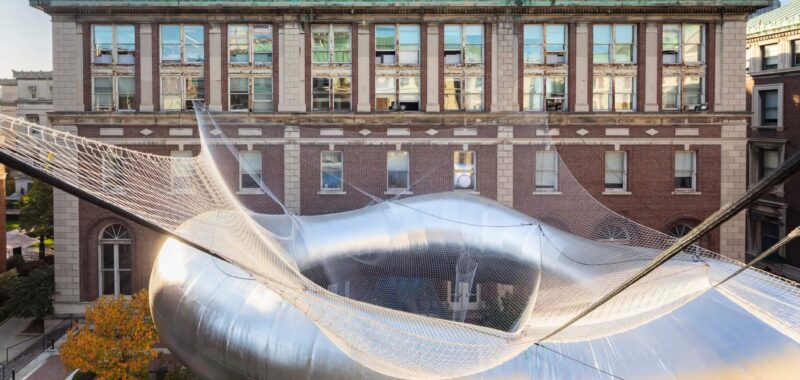Each year at Columbia University GSAPP students and faculty collaborate on a temporary activation of the courtyard connecting Avery, Fayerweather, and Schermerhorn Halls. For the past few years inflatables and hanging cables have been popular, and this year is no exception: This year’s installation is titled Cloud. A fitting title for the amoebic, metallic inflatable form that hovers above GSAPP’s crossroads, this year’s design was led by faculty members Laurie Hawkinson and Galia Solomonoff.

As a recent graduate of GSAPP, I personally remember the courtyard activation as a highlight of the annual Open House festivities. Falling this year on October 21, Open House is a day for new and prospective students and their families to visit the campus, get a feel for each program, and ask questions of students and faculty. There is always an energy surrounding Open House: Student work is on display, food and drinks are offered to all, and special lectures are organized.
Open House is one of the best times to see—and use—the GSAPP courtyard. In theory, the space should be a much more vibrant place than it is on non-Open House weeks, when it lies mostly dormant. The brick expanse serves as the roof of Avery Library’s very ‘70s expansion—an underground cavern designed by then-chair of the Architecture School Alexander Kouzmanoff. This expansion houses windowless study rooms and stacks much less preferable to the grand historic study spaces above, though it is quite amenable to sensitive collections like the venerable Avery Classics.

Above, the courtyard is bricked, slightly raised thanks to several shallow steps, and resolves in a nice plinth dotted with stone benches, green hedges, and the occasional park picnic table. So many wonder why the space isn’t nearly as popular as, for example, the Uris Hall steps sculpture park. One explanation may be because GSAPP only haphazardly occupies their corner of Columbia’s campus. M.Arch students are packed like sardines into Avery studios, and everyone else shares space with intro undergraduate seminars and STEM laboratories in Schermerhorn and Fayerweather—the former a maze with its own misguided midcentury addition, Schermerhorn Extension, which houses a basement-level, poorly ventilated shop for architecture students (if you can find it) and the latter mostly a labyrinth of dated undergrad lecture halls. Even Columbia’s vast network of underground tunnels and corridors, thanks to the campus’s platform design, cannot bring together the five disciplines housed in GSAPP.
So the Open House courtyard activation is the school’s annual outreach, an intentional yet temporary invitation for connection. With guidance from Hubert Chang and Silman Structural Engineers, the fabrication of the metallic inflatable was made possible by Àrea Cúbica and teaching assistants Tristan Schendel and Syed Haseeb Amjad, and of course dozens of student contributors spanning the spring and fall 2024 semesters.

Cloud engages each of the surrounding halls up to the 400 level. Various points of the “cloud” rain down netting: each net contains an amoebic chair. The seating can be moved, rearranged, and customized by dragging the nets like a curtain across the court. To supplement, there are also student-designed stools made of CMUs and ovoid pieces of plywood. On Columbia GSAPP’s Instagram, one can see students rearranging seats in the twilight, ostensibly for a studio smoke break or informal dinner gathering. But the courtyard has also hosted midterm reviews—easels, tables, and podiums were brought outside and seats were rearranged by students and jury members, moved with each new presentation.
GSAPP’s outdoor space is so enjoyable during Open House because the courtyard is activated in terms of design, circulation, and program. There is suddenly better seating, more people, and cafe-style service: buffets of food, bars, tables, and lights. It feels like what a courtyard should feel like, allowing students and visitors to both rest and network, take a break from the chaos and have more intimate conversations.
That’s why it’s a shame it’s all so temporary. Cloud will only grace the courtyard space for about three weeks, until October 30. But the activation always gets students (and hopefully faculty) thinking about how things could be better. This year’s Cloud is unique in that it doesn’t just remain in the courtyard. The playful inflated metallic forms are also installed in various doorways to classrooms and offices. Resembling a metallic curtain, it beckons you to go through and experience Cloud even from inside the buildings surrounding it.
What if the hallowed historic studios of Avery better connected with the shop, the preservation lab, the state-of-the-art yet hidden underground urban design studios? What if Avery had a back porch as well as a front porch? What if the courtyard lost its chains and fences, and actually built proper ADA-compliant ramps rather than enduring another year of temporary plastic ones? For a campus where space is a premium, GSAPP’s courtyard is brimming with potential to unite a siloed design school. There are good bones, plantings, and sturdy historic material. All we need is the imagination instigated every year by students for the Open House to last a little longer.

